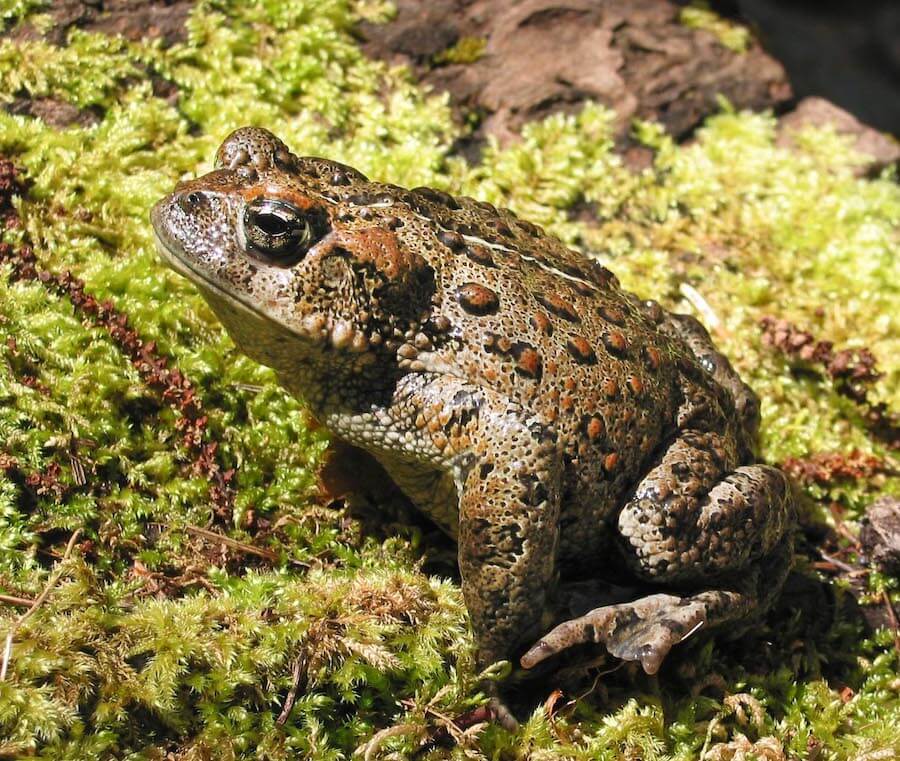Find the Toads, Count the Toads, Save the Toads
By Emma Swartz
Broadcast 6.14 & 6.17.2023

Western toad. Photo by Ivan Phillipsen, courtesy of Oregon State University, CC by-SA 2.0.
Listen:
It’s June and I’m in a dreamy meadow deep in the backcountry of Mount Rainier National Park, looking for toads. My mission: find the toads, count the toads, save the toads—in that order. I’m participating in a ten-year amphibian monitoring project that directly informs park management decisions regarding aquatic ecology and watershed health management. I don’t have to search long before I find my quarry: western toad eggs. I count and I count; there are hundreds and hundreds of eggs lying like strands of black pearls in the water. I’m satisfied.
I return in July. The snow has melted, the sun is out, and I wait for a happy-looking black bear to leave the ponds before I wander out to look for the toads. But the ponds have shrunk, revealing sandy brown edges speckled with black dots. A closer look reveals those dots are dried-up toad eggs, left to shrivel up in the sun as the water levels recede. I wander from pond to pond, all significantly smaller than the last time I saw them, all with clusters of dead eggs on the sunbaked outskirts. I save the largest two ponds with the most water in them for last, fingers crossed for signs of toad life. I look past the disconcerting number of dehydrated eggs on the bank, and triumphantly spot wriggling tadpoles! I count them and head back down the mountain, happy to have found some survivors, but nervous for what I’ll find at next month’s visit.
It’s August and my rounds on the ponds begin again. I nervously zigzag up the deer trail that takes me to, so far, mostly toadless ponds. I’ve seen this pattern all summer. July was too hot, so toad and other amphibian eggs dried up as the water levels receded. This prevented eggs from metamorphosing into tadpoles and tadpoles from metamorphosing into toads. I have brought buckets and nets with me this time, anticipating a rescue effort of moving tadpoles to whichever pond has the most water.

One tiny western toadlet! Photo © Emma Swartz.
I break out of the trees into the sunshine and immediately see brown, muddy holes where the ponds once stood, not a glimmer of water in sight. I walk slowly, taking in the remnants of life that once was, looking for survivors. I scan the edges of the ponds closely, looking for any tiny toadlets who’ve metamorphosed from larvae. And I spot a tiny survivor! I catch the little toad and hold it in my palm. It’s the size of my fingernail and has the trademark western toad bright yellow stripe down the middle of its back and dark-green bumpy skin. I write a triumphant “one” on my data sheet for the day.
This was my summer working at Mount Rainier National Park. Find the toads, count the toads, and save the toads. Of the fourteen known species of amphibians in the park, the western toad is of particular interest due to its candidacy for being listed as an endangered species in Washington state. A lower-than-average snowpack and warmer-than-average summer in 2019 contributed to decreased amphibian count numbers and many early deaths. It’s easy to think a sunny meadow tucked away in the backcountry of a glaciated volcano is safe from the climate crisis we’ve created, but the dried-up eggs and larvae of thousands of toads tell us otherwise. My research also showed increased counts of amphibian diseases like chytrid fungus and ranavirus. These diseases manifest as malformed limbs and sloughing off skin that leads to suffocation.
I live in Missoula, Montana, now, and I still keep my eye out for my plump, warty friends. The western toad is listed as a species of concern here, and it’s not hard to guess why. We too have warmer-than-average summers resulting in extra-warm waters and lowered water levels, both quite unfriendly to toads and other water-dependent species. But Montana is the last best place, and if we take action as the climate crisis demands, maybe it can be the last best place for western toads too.The mission is simple: find the toads, count the toads, save the toads.
Every week since 1991, Field Notes has inquired about Montana’s natural history. Field Notes are written by naturalists, students, and listeners about the puzzle-tree bark, eagle talons, woolly aphids, and giant puffballs of Western, Central and Southwestern Montana and aired weekly on Montana Public Radio.
Click here to read and listen to more Field Notes. Field Notes is available as a podcast! Subscribe on Apple Podcasts or wherever you listen to podcasts.
Interested in writing a Field Note? Contact Allison De Jong, Field Notes editor, at adejong [at] montananaturalist [dot] org or 406.327.0405.
Want to learn more about our programs as well as fun natural history facts and seasonal phenology? Sign up for our e-newsletter! You can also become a member and get discounts on our programs as well as free reciprocal admission to 300+ science centers in North America!












